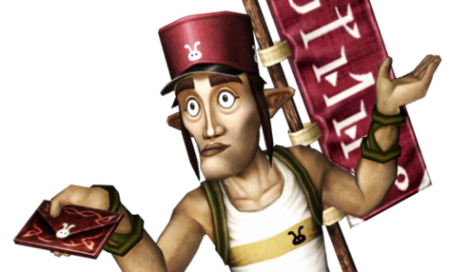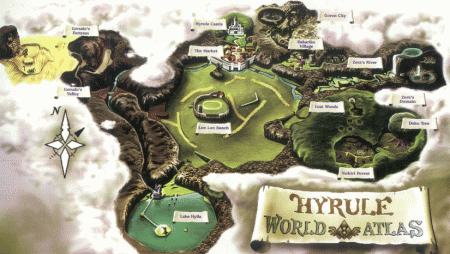Bomber’s Notebook #026 – Hyrule: Bizarre Monarchy
Posted on October 30 2012 by Majora's Cat
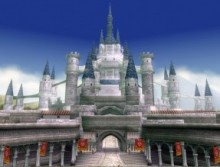 The kingdom of Hyrule itself and its real world correspondents haven’t been a subject of exploration in the past few years. That’s why I’d like to delve deeper into this bizarre world and explore its economy, real life counterparts and the inner mechanisms of its government. Its appearance, structure and culture have evolved since each Zelda game that used Hyrule as its backdrop essentially reinvented the region. At the core of every version is Hyrule is a shared structure that contain attributes including centralization, class division and forms of government that they all share. Make the jump to read more!
The kingdom of Hyrule itself and its real world correspondents haven’t been a subject of exploration in the past few years. That’s why I’d like to delve deeper into this bizarre world and explore its economy, real life counterparts and the inner mechanisms of its government. Its appearance, structure and culture have evolved since each Zelda game that used Hyrule as its backdrop essentially reinvented the region. At the core of every version is Hyrule is a shared structure that contain attributes including centralization, class division and forms of government that they all share. Make the jump to read more!
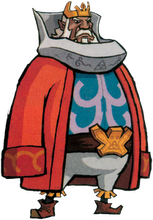 Let’s go over what has been established. Hyrule is ruled by a single sovereign king, making it a monarchy. However, this king appears to be something of a figurehead that doesn’t exercise much authority over the people. That leads me to believe that the real power lies in the hands of a preliminary Parliament or council that the player is unaware of. Ganondorf served as one of the king’s trusted advisers in Ocarina of Time, which may suggest the existence of a cabinet. Now of course the king may be the one making important decisions, but that idea has never been expressed in a Zelda game. Such is the case with quite a few supreme rulers in history – they never did take much control of their respective countries. Their advisers and councilmen close to the king worked behind closed doors pulling the strings. It could really be either one, since identity of the figure or figures of authority is open to interpretation.
Let’s go over what has been established. Hyrule is ruled by a single sovereign king, making it a monarchy. However, this king appears to be something of a figurehead that doesn’t exercise much authority over the people. That leads me to believe that the real power lies in the hands of a preliminary Parliament or council that the player is unaware of. Ganondorf served as one of the king’s trusted advisers in Ocarina of Time, which may suggest the existence of a cabinet. Now of course the king may be the one making important decisions, but that idea has never been expressed in a Zelda game. Such is the case with quite a few supreme rulers in history – they never did take much control of their respective countries. Their advisers and councilmen close to the king worked behind closed doors pulling the strings. It could really be either one, since identity of the figure or figures of authority is open to interpretation.
Hyrule has shown signs of being a semi-advanced civilization. There is free trade, people perform specialized jobs to make the kingdom a cohesive unit, there are class divisions to some extent, worship in deities, a centralized government, educational buildings, believe in the occult and a type of currency. It is a fairly peaceful kingdom that is often divided into sub-cultures. The Zora, Gorons, Kokiri, the Gerudo, Ritos, Koroks, Hylians, Lokomo and and Minish have their own distinct cultures. Their architecture, forms of transportation and even their beliefs differ to some extent.
It is also endorses the idea of capitalism and free market. People are not burdened with taxes and make full use of the freedom of enterprise. Denizens of Hyrule sell use weaponry, gadgets, foods, potions and more. World hubs will often house the most shops, serving as trade centers. However, there isn’t really an established system of trade. It’s disorganized, loose and lacks enough evidence to accurately discern how exactly trading works. On the other hand, the Hylian language is straightforward and universal. Communication is already remarkably advanced, as postmen will walk (or fly) to mailboxes across the land or deliver them by hand to the recipients.
A parallel could be drawn from Hyrule to the holy city of Jerusalem. While the kingdom of Hyrule is a vast expanse divided into incredibly diverse regions, the city of Jerusalem is separated into the Christian Quarter, Muslim Quarter, Temple Mount, Jewish Quarter and Armenian Quarter where people of different religious dedication reside. Ocarina of Time‘s interpretation of Hyrule featured Hyrule Field and Hyrule Castle where the Hylians are located, Zora’s Domain, Death Mountain for the Gorons, the Kokiri Forest, Lake Hylia and Gerudo Valley are the major regions of Hyrule. While they may not necessarily be disassociated by religion, they lead vastly incomparable lifestyles.
In a way, Hyrule resembles the ancient civilizations of Egypt and Mesopotamia. Ancient city-states were governed by their own leaders, who were likely subordinates of the principal leader of the civilization. There could be many central powers and vital commercial centers. The concept is equally applicable to Hyrule. This is evident in Ocarina of Time, but also rears its face in Twilight Princess, The Wind Waker and The Minish Cap. Death Mountain is a patriarchy, meaning all authority is directed towards men. In fact, there is no evidence whatsoever of Goron women. The Patriarch assumes the leadership role naturally with the Goron Elders serving as an advising council of sorts. The Zora were lead by the late Queen Rutela, but after her passing the position was shifted to her son.
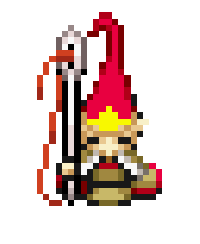 The Rito of The Wind Waker are similarly under the supervision of the Rito Chieftain, a nod to the indigenous Native American culture. Gorons become traveling merchants or drifters with no leader. They don’t band together like nomads and simply float around trying to trade their goods. The Koroks are united by the Great Deku Tree, who serves as a father figure, a leader and a deity at the same time. In The Minish Cap, the Minish Elder fits into a role similar to that of the Patriarch of the Goron tribe of Twilight Princess. Even the Minish are divided into sub-groups, forming the Forest Minish, Town Minish and Mountain Minish each with their own Minish Elders.
The Rito of The Wind Waker are similarly under the supervision of the Rito Chieftain, a nod to the indigenous Native American culture. Gorons become traveling merchants or drifters with no leader. They don’t band together like nomads and simply float around trying to trade their goods. The Koroks are united by the Great Deku Tree, who serves as a father figure, a leader and a deity at the same time. In The Minish Cap, the Minish Elder fits into a role similar to that of the Patriarch of the Goron tribe of Twilight Princess. Even the Minish are divided into sub-groups, forming the Forest Minish, Town Minish and Mountain Minish each with their own Minish Elders.
Unfortunately, Nintendo skimped on any specifics that indicate the finer points of a modern civilization being present in Hyrule. What can be deduced from the reigns of Chancellor Cole (Spirit Tracks), the King of Hyrule (Ocarina of Time) and King Daltus (The Minish Cap) reveal that most of their actions in office have to do with commanding Soldiers or Guards. In A Link to the Past and Four Swords Adventures, said Soldiers become enemies to Link because they are being possessed by the magic of Ganon and Vaati.
The kings of Hyrule are often described to be kind-hearted, fair rulers that are beloved by the people. It seems that the king’s rule does not imply anything other than controlling the Soldiers and acting as a figurehead. Hyrule yields no traces of a law system, a lack of a constitution, few trading hubs, etc. The standardization of currency is fantastic, as Rupees are widespread and used by all races of Hyrule.
Now of course Nintendo didn’t feel the need to elaborate much on Hyrule’s government, but if one pieces together all the facts that can be insinuated, we are left with an unclear image of Hyrule. In theory it is still an antediluvian, primitive monarchy with a somewhat useless ruler. So what are your thoughts on this editorial? What kind of government do you think Hyrule has? Are there any countries or cities in real life that you would like to compare it to? Feel free to leave a comment using the Disqus system!



